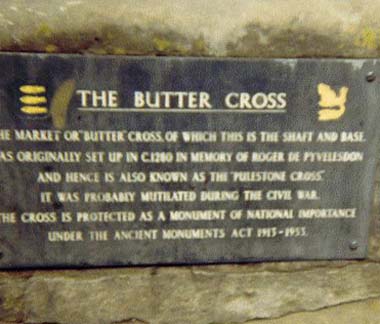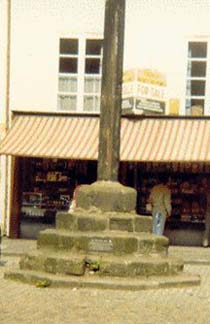 |
 |
Puleston is a hamlet north of Newport,
in the parish of Chetwynd, Shropshire. Early maps show it as “Pelvesdon”.
Domesday Book calls it “Pilston” and states “Thurold de Verley held it
in Edward the Confessor’s time. The Manor was worth 8/- per annum
(Tax).
Roger de Pyvelesdon was appointed “Sheriff of Shropshire”
in 1241. A deed signed in 1285 by Roger Puleston, son of the above, refers
to “The Cross set up for the soul of Roger de Puleston who died in 1272.” This
cross now stands in Newport, High Street, near the parish church and on
it the following inscription: (3)
|
The Market or “Butter” Cross of which this is the shaft
and base,
|
 |
 |
Roger, as Sheriff, was witness to an important Charter granted to Haughmond Abbey. The most interesting local act for which he was responsible, concerned the famous Vivary (Fish Farm) at Aqualate, Newport. The burgesses of Newport had been responsible for carrying fish from the Vivary to the King’s Court, whenever it may be held in the country. Roger’s efforts released the burgesses from carrying the fish outside Shropshire.
One of Roger’s sons, Thomas, married
Helen, niece of Michael Tovey, who had been mayor of London in 1244 and
1248. In 1263 Thomas was made a Royal Justice, but he joined Simon
de Montfort at the Battle of Lewes, and when de Montfort was killed at
Evesham in 1265, Thomas and Michael Tovey were arrested and imprisoned
in Dover Castle. Thomas was released in 1276 but died in 1277.
Another son Roger married Agnes daughter of David le
Clerk, Baron of Malpas. Roger with his son Richard went to North
Wales at the command of King Edward I, to held with the organizing of the
Welsh. Richard was appointed Sheriff of Caernarfon and given an estate
at Emral in the parish of Worthenbury, Flintshire, 1277. He became
Sir Richard Puleston of Emral, Knight.
In 1293, Edward I needed money for his wars with France. He again sent Roger Puleston to North Wales to collect taxes. This led to the “Insurrection of Madoc” 1293-94. Roger was taken by surprise, hanged and beheaded outside his home “Plas Puleston”, Caernarfon.
A Robert Puleston married Lowri sister of Owain Glyn Dwr, whom he joined in the rising against Henry IV 1400. Owain lost the battle, and Robert forfeited the Emral Estate but it was later restored to the Pulestons. He also forfeited Warrens Hall, Stoke on Tern, Shropshire which had been held by the Pulestons since 1285.
Hugh Puleston was the Vicar of Wrexham Church 1520-15 The Rev. T.H.G. Puleston, Bart. Vicar of Worthenbury dies 1890. The Chantry Chapel of the Puleston Family was in Wrexham Parish Church at the Eat End of the North Aisle.
Catherine Puleston of Emral married Sir Richard Trevor in 1610. The Chantry Chapel of the Trevor Family was in Gresford Parish Church in the South Chancel Aisle.
In Worthenbury Church there is a Box Pew dated 1282 belonging to the Pulestons of Emral. The Pew contains a fireplace. The Pulestons have a burial place in Bangor on Dee Church for the Pulestons of Pickhall Hall 1799-18??.
At Uffington Church, Shropshire in 15th February 1798 Richard Puleston of Emral married Emma Elizabeth Corbett of Sundome Castle. Richard became 2nd Baron of Emral.
Emma Puleston was a famous beauty at the time of King George IV when he was Prince Regent. To pay for her expensive style of living, plus gambling debts, a large part of the Emral estate had to be sold. The rest of the estate was sold to pay death duties of later Pulestons. The Hall fell into disrepair and was demolished in 1953. An elaborate plaster ceiling from the Hall was re-erected at Portmeirion Hall, North Wales.
(1) Mrs. Sunter Harrison of Wrexham wrote the books: The Early Pulestons (1975, ISBN 0950478407) and: Worthenbury Church, Emral Chapel and the Pulestons (1990, ISBN 0950478415). These books can be found at the National Library of Wales.
(2) Mr. W. D. Lea died in 1997. This work has been shared by his daughter, Mrs. Margaret Littlejohn of New Waterford, Cape Breton.
(3) From a defunct web site of "The Public Monument and Sculpture Association" where it was stated: "The market cross consists of five steep octagonal steps leading to the remains of a square-sectioned fluted shaft. . . Sandstone . . . Overall 500cm high . . . Moss on the top of the shaft, lichen on the steps . . . All of the cross is heavily weathered." (Dated January 2003)
This page was posted by Robert Sewell in June 2006.
 |
Click to return to the Puleston Page.
Please visit the Sewell Genealogy Site Map for other pages in this series.